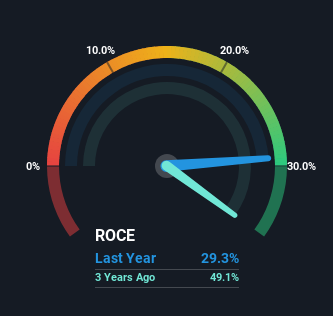Philip Morris International (NYSE:PM) Is Reinvesting At Lower Rates Of Return
What trends should we look for it we want to identify stocks that can multiply in value over the long term? One common approach is to try and find a company with returns on capital employed (ROCE) that are increasing, in conjunction with a growing amount of capital employed. Put simply, these types of businesses are compounding machines, meaning they are continually reinvesting their earnings at ever-higher rates of return. Looking at Philip Morris International (NYSE:PM), it does have a high ROCE right now, but lets see how returns are trending.
Understanding Return On Capital Employed (ROCE)
If you haven't worked with ROCE before, it measures the 'return' (pre-tax profit) a company generates from capital employed in its business. The formula for this calculation on Philip Morris International is:
Return on Capital Employed = Earnings Before Interest and Tax (EBIT) ÷ (Total Assets - Current Liabilities)
0.29 = US$12b ÷ (US$63b - US$22b) (Based on the trailing twelve months to September 2023).
Therefore, Philip Morris International has an ROCE of 29%. That's a fantastic return and not only that, it outpaces the average of 18% earned by companies in a similar industry.
View our latest analysis for Philip Morris International
In the above chart we have measured Philip Morris International's prior ROCE against its prior performance, but the future is arguably more important. If you'd like, you can check out the forecasts from the analysts covering Philip Morris International here for free.
What The Trend Of ROCE Can Tell Us
On the surface, the trend of ROCE at Philip Morris International doesn't inspire confidence. While it's comforting that the ROCE is high, five years ago it was 50%. Meanwhile, the business is utilizing more capital but this hasn't moved the needle much in terms of sales in the past 12 months, so this could reflect longer term investments. It may take some time before the company starts to see any change in earnings from these investments.
The Bottom Line
Bringing it all together, while we're somewhat encouraged by Philip Morris International's reinvestment in its own business, we're aware that returns are shrinking. Since the stock has gained an impressive 82% over the last five years, investors must think there's better things to come. Ultimately, if the underlying trends persist, we wouldn't hold our breath on it being a multi-bagger going forward.
Like most companies, Philip Morris International does come with some risks, and we've found 2 warning signs that you should be aware of.
Philip Morris International is not the only stock earning high returns. If you'd like to see more, check out our free list of companies earning high returns on equity with solid fundamentals.
Have feedback on this article? Concerned about the content? Get in touch with us directly. Alternatively, email editorial-team (at) simplywallst.com.
This article by Simply Wall St is general in nature. We provide commentary based on historical data and analyst forecasts only using an unbiased methodology and our articles are not intended to be financial advice. It does not constitute a recommendation to buy or sell any stock, and does not take account of your objectives, or your financial situation. We aim to bring you long-term focused analysis driven by fundamental data. Note that our analysis may not factor in the latest price-sensitive company announcements or qualitative material. Simply Wall St has no position in any stocks mentioned.

